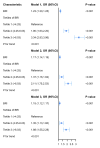Association between body roundness index and overactive bladder: results from the NHANES 2005-2018
- PMID: 38867211
- PMCID: PMC11167800
- DOI: 10.1186/s12944-024-02174-1
Association between body roundness index and overactive bladder: results from the NHANES 2005-2018
Abstract
Background and aim: An increasing amount of research has indicated obesity greatly affects individuals with overactive bladder (OAB). However, traditional anthropometric methods present challenges in accurately assessing the likelihood of OAB. Hence, this study's objective was to identify the correlation between the body roundness index (BRI) and OAB.
Methods: The research included 12,401 individuals who participated in the National Health and Nutrition Examination Survey spanning 2005-2018. The correlation between BRI and OAB was explored by using weighted multiple logistic regression and weighted restricted cubic spline (RCS). Subgroup analyses showed the associations based on different population types. The study also analyzed the predictive capability of various anthropometric indices, including BRI, body mass index, waist circumference, and weight, in assessing the likelihood of OAB through Receiver-operating characteristic (ROC) curves.
Results: An independent positive correlation between OAB and BRI was identified after adjusting for potential confounders in weighted multivariate logistic models[odds ratio (OR) = 1.15, 95% confidence interval (CI), 1.12-1.17]. Weighted RCS analysis found a positive dose-response correlation between OAB and BRI. The effect size of BRI on OAB remained stable across all prespecified subgroups (all P for interactions > 0.05). In ROC analysis, BRI showed better discriminatory ability for OAB compared with other anthropometric measures for both genders (all P < 0.01). The best BRI cutoff for predicting OAB was lower for men (5.151) than for women (5.383), suggesting that men were more susceptible to changes in BRI than women.
Conclusions: This study demonstrated that a raised BRI is correlated with a higher likelihood of OAB. Due to the effectiveness and non-invasiveness of BRI in predicting OAB, it is expected to become the preferred method for early detection and management strategies.
Keywords: Body roundness index; Cross-sectional study; NHANES; Overactive bladder.
© 2024. The Author(s).
Conflict of interest statement
All authors declare that the study was conducted without any conflicts.
Figures





References
-
- Irwin DE, Milsom I, Hunskaar S, Reilly K, Kopp Z, Herschorn S, et al. Population-based survey of urinary incontinence, overactive bladder, and other lower urinary tract symptoms in five countries: results of the EPIC study. Eur Urol. 2006;50(6):1306–14. doi: 10.1016/j.eururo.2006.09.019. - DOI - PubMed
-
- Sexton CC, Coyne KS, Vats V, Kopp ZS, Irwin DE, Wagner TH. Impact of overactive bladder on work productivity in the United States: results from EpiLUTS. Am J Manag Care. 2009;15(4 Suppl):S98–107. - PubMed
MeSH terms
Grants and funding
LinkOut - more resources
Full Text Sources
Medical

